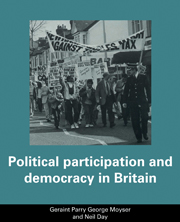Book contents
- Frontmatter
- Contents
- List of figures
- List of charts and maps
- List of tables
- Preface
- Part I Theories and methods
- Part II Patterns and pathways
- 3 Patterns of political participation
- 4 Individual resources
- 5 Group resources
- 6 Economic location
- 7 Personal factors
- 8 Political outlooks
- 9 Party and values
- 10 Who are the political activists?
- Part III Issues and actions
- Part IV The local process
- Part V Conclusions
- Appendix A Survey methods
- Appendix B Measuring elite-citizen concurrence
- Appendix C The National Questionnaire
- Endnotes
- Bibliography
- Index
10 - Who are the political activists?
Published online by Cambridge University Press: 03 May 2011
- Frontmatter
- Contents
- List of figures
- List of charts and maps
- List of tables
- Preface
- Part I Theories and methods
- Part II Patterns and pathways
- 3 Patterns of political participation
- 4 Individual resources
- 5 Group resources
- 6 Economic location
- 7 Personal factors
- 8 Political outlooks
- 9 Party and values
- 10 Who are the political activists?
- Part III Issues and actions
- Part IV The local process
- Part V Conclusions
- Appendix A Survey methods
- Appendix B Measuring elite-citizen concurrence
- Appendix C The National Questionnaire
- Endnotes
- Bibliography
- Index
Summary
We can now draw together some of the materials presented in the previous chapters. So far, we have been examining the various modes of participation and have been showing how far these different ways of taking action have been pursued by people with differing patterns of resources, or from contrasting personal backgrounds, or who hold competing political attitudes. First, we shall try to consolidate these findings in an analysis that highlights their key elements. Secondly, we shall offer an alternative way of looking at the findings. This is to group individuals according to their greater or lesser propensity to pursue one kind of action rather than another. It is then possible to delineate the resource, personal and attitudinal profiles of each of these types of participant. In this way, the reader can gain an additional perspective on participation in Britain.
What makes for political activism?
As has been shown, the answer to what makes for political activism is not straightforward. Resources explain a lot, but more in some areas of participation than others (see figure 5.10). Equally, other important economic and personal factors we have considered add to the picture, but to varying degrees and sometimes only in combination with other attributes. The gender gap is one instance. It is also the case that, in many of the relationships reported, the effect varies from one part to another. The impact of age, for example, is of this sort – depressing participation amongst young and very old, raising it for those in between.
- Type
- Chapter
- Information
- Political Participation and Democracy in Britain , pp. 225 - 238Publisher: Cambridge University PressPrint publication year: 1992



